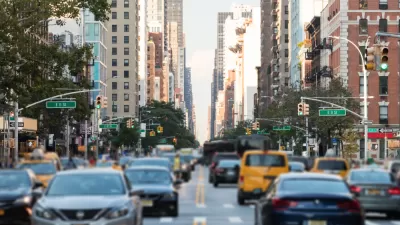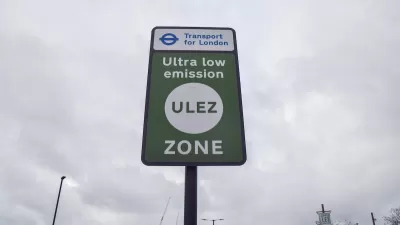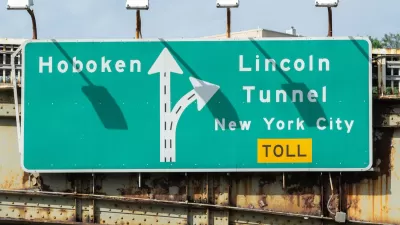Cities significantly underprice their roads and parking facilities, forcing local taxpayers to subsidize out-of-town motorists. Municipal officials have an obligation to better manage these valuable public resources.
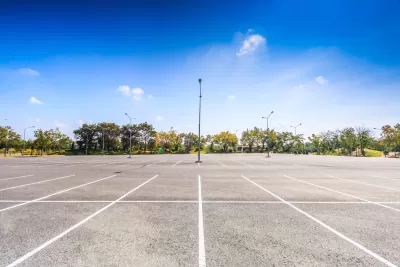
A fiduciary obligation refers to a professional person's legal responsibility to wisely manage assets with which they are entrusted. One of the most valuable assets [pdf] cities own is their road rights-of-way, the land dedicated to streets, public parking, and sidewalks. It typically represents 5-15% of a city’s total land base [pdf], and serves unique and valuable roles by providing mobility and accessibility between destinations, as well as being the community’s public realm. Cities officials have a fiduciary responsibility to manage these assets to maximize their citizens' benefits. They currently fail to do so.
As mentioned in my recent blog, "The 'War on Cars' Is a Bad Joke," user fees only cover a portion of local road and parking facility costs. For example, in the United States, fuel taxes and tolls provide only about half of total roadway spending, and are mostly spent on interstate highways. Most local roads, traffic services, and public parking facility costs are funded by local taxes that residents pay regardless of how they travel.
These costs are significant, especially under urban-peak conditions. There are various ways to calculate roadway infrastructure costs [pdf] and therefore the fair and efficient price [pdf] for using public roads. At a minimum, users should pay marginal costs, that is, the incremental facility operating and maintenance costs required for their vehicle travel, plus a fee that represents the congestion costs they impose on other road users. More comprehensive pricing, called cost recovery pricing, also charges users a share of total facility costs, including past construction costs (for example, repaying construction bonds), plus the equivalent of rent on road rights-of-way.
During off-peak periods, marginal costs are typically just 5-10¢ per vehicle-mile [pdf], with higher rates for heavy vehicles, such as buses and trucks due to the additional road wear they impose. Cost recover prices are about twice this to also repay construction and land costs. Under urban-peak conditions, efficient prices are typically 25-75¢ per vehicle-mile, reflecting infrastructure operation and maintenance expenses, plus the congestion costs a vehicle imposes on other road users, or the costs of expanding roads to accommodate additional traffic. In addition, an urban parking space typically costs $5-15 per day [pdf]. As a result, a rational city would charge a typical automobile commuter $5.00-25.00 per day for driving under urban-peak conditions and parking all day on public streets, depending on conditions.
Most cities significantly underprice these facilities. Cities give away most road space and only charge for a small portion of public parking. This is economically inefficient and unfair. Roadway underpricing increases urban traffic problems including congestion, road and parking facility costs, accident risk, and pollution problems, which reduces urban neighborhood livability and property values. It forces local residents to subsidize the facility costs of motorists, many of whom live in other jurisdictions and so pay few local taxes.
These subsidies consist of a combination of government expenditures on road and parking facilities, plus revenue foregone from potential user fees not collected. Efficient pricing would treat roads and parking facilities as valuable public assets that should generate revenues to provide public services or reduce other taxes. Such pricing would also reduce vehicle travel, particularly under urban-peak conditions, which would reduce traffic problems, creating more livable urban neighborhoods.
Defenders of roadway underpricing could argue that these costs are reciprocated; that for every motorist driving into the city a city resident drives to another community where they impose comparable costs, but this is generally not true. In most regions, far fewer city residents drive to suburbs than vice versa, and roadway costs are much higher in cities than in suburbs due to their greater traffic densities and land values.
Let me illustrated this with data from our regional Travel Survey [pdf]. It shows (page 88) that on an average weekday morning, 21,680 motorists drove into Victoria but only about half as many, 11,340, drove out. On the other hand, in the nearby suburb of Langford (page 112), only 5,050 motorists drive in, about half the 9,360 who drive out each morning, and in the more distant suburb of Sooke (page 118), just 870 motorists drove in compared with 2,110 who drive out. This indicates that for every Victoria resident who commutes to a suburb about two suburban residents commute by car to our city, and since Victoria has more congested roads and higher land values, Victoria taxpayers subsidize suburban motorists many times more than suburban taxpayers subsidize Victoria motorists. I expect that similar patterns exists in most urban regions: city residents subsidize out-of-town motorists' roadway costs.
Defenders could argue that such underpricing is fair since everybody has an equal opportunity to use roads and parking facilities, but of course, not everybody can or wants to drive, and driving rates are much higher in suburbs than cities. In practice, underpricing roadway and parking facilities causes taxpayers who drive less than average to subsidize the costs of those who drive more than average, and forces urban taxpayers to subsidize the road and parking facilities used by suburban motorists who visit their city. Since urban automobile travel tends to increase with income, this is regressive. Efficient road and parking pricing tend to benefit lower-income residents overall, particularly if a portion of revenues are used to improve non-auto modes or used to provide other benefits to lower-income residents.
Somebody might also argue that urban non-drivers receive equal subsidies in the form of tax dollars spend on walking and bicycling facilities, and public transit services, but those are generally smaller than automobile subsidies. In urban areas, public transit services are cost efficient due to high load factors; many urban bus routes recover their costs. It is in suburban areas with low ridership that transit services require large subsidies. Only a few percent of total transportation expenditures are devoted to walking and bicycling facilities, as described in the Bicycling and Walking Benchmarking Reports. Since motorists tend to travel far more annual miles than people who rely primarily on other modes, motorists receive far greater public subsidies per capita.
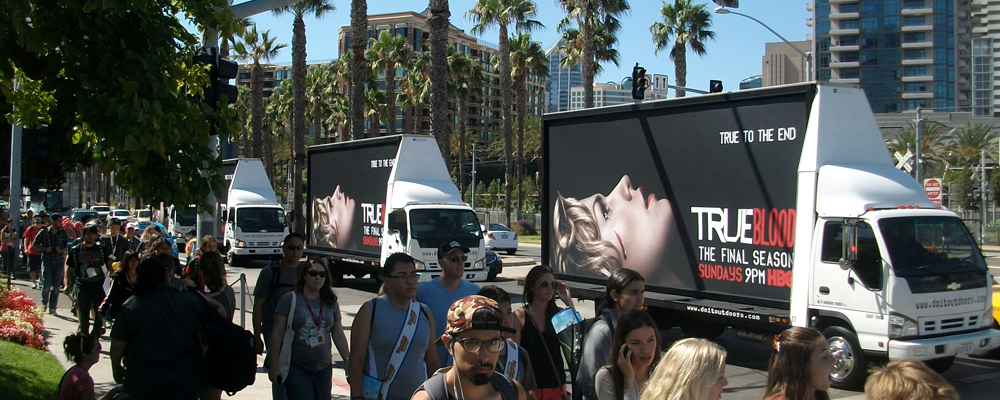
Mobile advertising, in which large trucks with large billboards drive around on busy urban streets, provides empirical evidence that road user charges are too low; there are many other possible ways to advertise that do not contribute to traffic congestion, accidents and pollution problems.
Some people might argue that automobile subsidies are needed to support local economic activities, for example, to attract customers to downtown shops and restaurants, and to allow employees to serve local businesses. Suburban motorists often threaten to stop visiting downtown if they increase parking prices, charge road user fees or implement more multi-modal planning; that would probably occur to some degree but overall economic impacts are mixed. Efficient pricing and multi-modal planning is likely to reduce automobile trips but improve access by other modes, which currently represent about half of all urban-peak downtown trips in our city, and this is likely to increase if non-auto travel conditions improve. By reducing local taxes and improving urban livability, efficient road and parking pricing can increase central city populations, who tend to support local economic activity much more than suburban motorists. Efficient pricing reduces traffic and parking congestion, which favors those customers who are willing to pay for a better shopping experience; you could say that it filters out the cheapskates. If roads and parking are free, a typical suburbanite might spend about $80 per month to shop or dine in our city, but only half as much if they are efficiently priced, reducing perhaps $500 in annual expenditures. A typical city resident spends ten to fifty times as much at local shops and restaurants, $5,000-25,000 annually, so if local tax reductions and improved livability attract a few thousand additional households, they can more than offset the loss of suburban shoppers.
Both theoretical and empirical evidence indicates that urban economies benefit from TDM policies that reduce automobile travel and encourage more resource-efficient travel. Economic productivity tends to be negatively correlated to automobile travel and positively correlated to public transit mode share, indicating that transportation demand management policies, such as efficient road and parking pricing, tend to have neutral or positive economic development impacts, as discussed in my report, "The Mobility Productivity Paradox" [pdf]. Efficient pricing reduces congestion, improve urban livability, and allows cities to achieve more agglomeration efficiencies. More efficient road and parking pricing may reduce some types of local business activity, such as drive-through restaurants, but benefits most others by improving non-automobile access and urban neighborhood livability.
These savings and benefits can be large. For example, our house is on a 60-foot wide lot that can accommodate two or three cars parked on the street. Like most residential streets, these parking spaces are unpriced. Nearby commercial parking lots charge $40-60 per month per space. At these rates, the curb in front of our house could generate between $960 (2 x $40 x 12) and $2,160 (3 x $60 x 12) annual parking revenue, which is from one-third to two-thirds of our total property taxes. Similarly, if the 21,680 motorists who drive into Victoria on an average weekday morning were charged $2 per day, 260 days per year, this would generate more than $10 million annually, approximately $120 per capita, about what our city currently spends on road maintenance each year. Of course, some motorists would probably respond by shifting mode, which would result in less revenue but would also reduce traffic problems and infrastructure costs, and improving neighborhood livability. In addition, increased transit demand and reduced bus congestion delays would benefit transit commuters.
This suggests that central cities could reduce local taxes by several hundred dollars annually per resident by charging motorists, many of whom are non-residents who pay no local taxes, for the road and parking facilities they use. The table below summarizes likely winners and losers.
Efficient Road and Parking Pricing Impacts
Winners |
Losers |
|
|
If asked to choose between free or priced roads and parking, most people would probably prefer free, but if faced with a more realistic choice, between living in a city where driving and parking is cheap but taxes are high and facilities are congested, or a community where motorists must pay to drive during peak periods and to park, but local taxes and traffic problems are significantly lower, and fewer tax dollars are spent subsidizing out-of-town motorists, I suspect that many city residents would choose efficient pricing. It's time to stop giving away our most valuable assets!
More efficient urban road and parking pricing deserve support from diverse interests. Political conservatives should support better management of public assets and reduced government subsidies for private gain. Political liberals support more multi-modal transportation planning and new revenues to provide local services. Transportation professionals support efficient pricing that reduces traffic congestion and infrastructure costs, increases safety [pdf], and generates revenues that can be invested in facility maintenance and new mobility services. Environmentalists should support reductions in pollution emissions and sprawl, and public health professionals should support incentives to walk and bicycle. Urban residents should appreciate reduced traffic volumes and new revenues that can be invested in local amenities. Everybody wins!
It's time to be rational. I would be unhappy if my property manager charged unjustified low rents or let their friends use my assets for free. Similarly, as a citizen and taxpayer, we should be unhappy if public officials fail to maximize the economic returns from valuable public assets by failing to implement road user fees when possible, or underpricing parking facilities. Most urban residents would benefit overall if public roads and parking facilities are priced to ensure efficient use and generate value to all residents, not just motorists.

Planetizen Federal Action Tracker
A weekly monitor of how Trump’s orders and actions are impacting planners and planning in America.

Restaurant Patios Were a Pandemic Win — Why Were They so Hard to Keep?
Social distancing requirements and changes in travel patterns prompted cities to pilot new uses for street and sidewalk space. Then it got complicated.

Map: Where Senate Republicans Want to Sell Your Public Lands
For public land advocates, the Senate Republicans’ proposal to sell millions of acres of public land in the West is “the biggest fight of their careers.”

Maui's Vacation Rental Debate Turns Ugly
Verbal attacks, misinformation campaigns and fistfights plague a high-stakes debate to convert thousands of vacation rentals into long-term housing.

San Francisco Suspends Traffic Calming Amidst Record Deaths
Citing “a challenging fiscal landscape,” the city will cease the program on the heels of 42 traffic deaths, including 24 pedestrians.

California Homeless Arrests, Citations Spike After Ruling
An investigation reveals that anti-homeless actions increased up to 500% after Grants Pass v. Johnson — even in cities claiming no policy change.
Urban Design for Planners 1: Software Tools
This six-course series explores essential urban design concepts using open source software and equips planners with the tools they need to participate fully in the urban design process.
Planning for Universal Design
Learn the tools for implementing Universal Design in planning regulations.
Heyer Gruel & Associates PA
JM Goldson LLC
Custer County Colorado
City of Camden Redevelopment Agency
City of Astoria
Transportation Research & Education Center (TREC) at Portland State University
Camden Redevelopment Agency
City of Claremont
Municipality of Princeton (NJ)



























